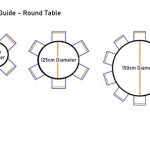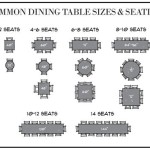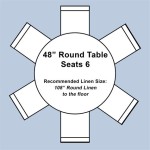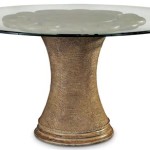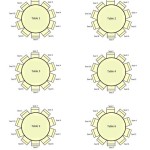Is A Round Dining Table Better For Small Spaces?
The question of whether a round dining table is superior for small spaces is a recurring theme in interior design discussions. The answer isn't always straightforward; it hinges on a variety of factors specific to the room's dimensions, layout, and the lifestyle of the inhabitants. While round tables offer certain advantages, considering alternatives and understanding limitations is crucial for making an informed decision.
The inherent advantages of a round dining table often stem from its shape. The absence of corners promotes a more fluid traffic flow in tight spaces. This can translate to fewer accidental bumps and bruises and a greater sense of openness. Furthermore, the circular form naturally encourages conversation and inclusivity, as everyone is visually connected and equidistant from the center of the table. The aesthetic appeal of a round table can also play a significant role, adding a touch of softness and visual interest to an otherwise angular environment.
However, a round table is not a universal solution. Rectangular tables, while potentially seeming less suitable at first glance, can sometimes utilize space more effectively, particularly in narrow or long rooms. Understanding the nuances of each shape and its potential impact on spatial perception is essential for achieving the desired outcome.
Advantages of Round Dining Tables in Small Spaces
One of the primary benefits of a round dining table in a small space is its ability to maximize floor space and improve maneuverability. Because round tables lack sharp corners, people can navigate around them more easily, minimizing the risk of collisions and creating a greater sense of spaciousness. This is particularly advantageous in apartments or homes where square footage is limited.
The absence of corners also makes round tables safer, especially for households with young children. The rounded edges significantly reduce the likelihood of bumps and scrapes, providing parents with greater peace of mind. This safety aspect is often overlooked but is a significant consideration for families designing their living spaces.
Beyond functionality, a round table can also enhance the aesthetic appeal of a small dining area. Its circular form introduces a sense of softness and elegance, contrasting with the often-harsh angles of walls and furniture. This can create a more inviting and comfortable atmosphere, making the dining space feel more welcoming.
The inherent sociability of a round table is another key advantage. With everyone facing each other, conversation flows more easily, fostering a sense of connection and intimacy. This makes round tables ideal for smaller gatherings and intimate dinners. The equal distance from the center of the table also promotes a sense of equality and inclusion, ensuring that everyone feels equally valued and engaged.
Furthermore, round tables often lend themselves well to pedestal bases, which further maximizes legroom and prevents awkward encounters with table legs. This is especially beneficial in small spaces where every inch counts. The pedestal base also contributes to a cleaner, more streamlined look, enhancing the overall aesthetic of the room.
Limitations of Round Dining Tables in Small Spaces
Despite their significant advantages, round dining tables are not without limitations, especially in certain types of small spaces. One of the main constraints is their potentially inefficient use of space, particularly in rooms that are long and narrow. In such scenarios, a rectangular table might be a better option, as it can be positioned against a wall to maximize floor space and create a more functional layout.
The seating capacity of a round table is also a factor to consider. While round tables can comfortably accommodate a certain number of people, adding extra chairs can be challenging. As the diameter of the table increases to accommodate more seating, the overall footprint also expands, potentially overwhelming a small space. This can limit the flexibility of the dining area and make it difficult to host larger gatherings.
Another potential drawback is the difficulty of pushing a round table against a wall. While this might seem like a minor issue, it can be a significant constraint in very small spaces where every inch of wall space is valuable. A rectangular table, on the other hand, can be easily placed against a wall to create more open space in the center of the room.
Furthermore, the lack of a defined head of the table can be a disadvantage in certain situations. In formal dining settings, a rectangular table with a designated head and foot can create a sense of hierarchy and formality. A round table, with its egalitarian design, may not be suitable for such occasions.
The availability of suitable round dining tables can also be a factor. While there are many round tables on the market, finding one that is the right size, style, and material for a specific small space can be challenging. Rectangular tables, on the other hand, are generally more readily available in a wider range of sizes and styles.
Alternatives to Round and Rectangular Tables for Small Spaces
While round and rectangular tables are the most common choices for dining areas, several alternative shapes and styles are worth considering, especially when space is limited. Drop-leaf tables, for example, offer exceptional versatility. They can be folded down to a smaller size when not in use, freeing up valuable floor space. When needed, the leaves can be extended to create a larger dining surface, accommodating more guests.
Square tables are another option that can work well in small, square-shaped rooms. They offer a good balance of functionality and aesthetics, providing ample seating without taking up too much space. Square tables also tend to be more readily available than round tables in certain styles and materials.
Oval tables can be a good compromise between round and rectangular tables. They offer the rounded edges of a round table, which promotes better traffic flow, while also providing more seating capacity than a round table of the same diameter. Oval tables can also be easier to push against a wall than round tables, making them a more versatile option for small spaces.
Booth seating is another space-saving solution that can be particularly effective in small apartments or studios. Booths can be built into a corner or along a wall, creating a cozy and functional dining area. They also offer built-in storage, which can be a valuable asset in small spaces.
Finally, consider a multi-functional piece of furniture that can serve as both a dining table and a coffee table. These tables typically have adjustable heights and expanding surfaces, allowing them to transform from a low coffee table to a higher dining table with ease. This is a particularly clever solution for very small spaces where every piece of furniture needs to serve multiple purposes.
Ultimately, determining whether a round dining table is superior for a small space requires careful consideration of the room's dimensions, layout, and the individual needs and preferences of the occupants. While round tables offer certain advantages in terms of traffic flow, safety, and sociability, they may not be the best option for every situation. Evaluating alternative shapes and styles, as well as understanding the limitations of each option, is essential for creating a functional and aesthetically pleasing dining area in a small space.

The Best Dining Table Shapes Castlery Singapore

Why You Should Love Round Dining Tables And Top Picks From

13 Best Small Space Kitchen And Dining Tables Of 2024 Top Picks

Why Round Dining Table May Work In Your Space 31 Examples

So What Is The Best Shape Of Dining Table For A Small Space First You Need To Round Rectangle Kitchen

How To Choose Dining Table Size Dimensions Macy S

Small Space Dining Table At Home With Ashley

How To Choose The Perfect Dining Table For Your Home Decoist

13 Small Dining Room Ideas And Decorating Tricks

1000mm Round Wooden Small Nesting Dining Table Set For 4 White Upholstered Chairs Homary
Related Posts

